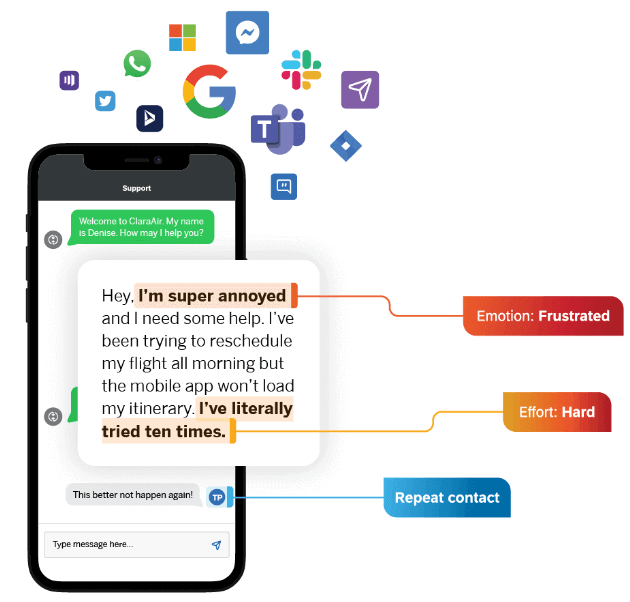Author: Adam Bunker
Subject Matter Expert: Dave Pabley
What is social media monitoring?
Social media monitoring is the act of using digital tools to keep tabs on specific mentions or messages across various social platforms. For brands, monitoring social media is important in understanding customer sentiment and opinions, responding quickly to queries – both direct and indirect – and understanding general customer trends.
This includes using social media monitoring tools to keep tabs on things like:
- Social media conversations
- Post engagement
- Brand sentiment
- Share of voice
- Customer support issues
- Emerging problems
People are talking with and about you every day on social media. Written posts, vertical videos, memes, shares, complaints, and queries are being published on every platform, every hour of the day. That makes the major social media channels goldmines of consumer insight – if you can capture and understand what’s being said. If not, that same volume of information can also make social media a potential reputational risk.
In that sense, social media monitoring is about much more than just counting likes and reposts. It’s the process of analyzing and understanding who’s talking about your brand, what they’re saying, and discerning the right strategy for what to do in each instance.
Listen to your customers and engage with them across all platforms
Social monitoring vs social listening
Social media monitoring and social media listening aren’t exactly the same thing, even if they do share a common focus – and both should be part of any good customer experience solution. Here’s how they differ:
Social media monitoring
Here you’ll be proactively keeping an ear to the ground across multiple platforms, scanning for social media mentions, posts, and videos about your business. This includes posts that don’t directly tag you. This practice will allow you to respond to posts in a timely manner – and potentially turn negative ones around.
Social media monitoring tools can do this at scale, with AI-powered Natural Language Understanding that not only detects when you’ve been mentioned but also the emotion and sentiment behind what’s being said.

Social media listening
Social media listening tends to focus on the bigger picture. That means tracking wider industry keywords to help understand consumer trends and sentiment. You can use social media listening to learn where you stand amongst the competition, with share of voice – the overall percentage of the conversation your brand occupies – often acting as a key social listening metric.
The benefits of social media monitoring
Social media monitoring has become such an important part of customer experience management programs because social platforms are incredible wells of information. Social posts can alert you to emerging issues or crises, help you understand where you’re missing the mark with your target audience, and even clue you into gaps in the market.
Here are a few key business benefits of running a social media monitoring program:
1. Reputation management
If someone makes a post complaining about an aspect of your product or service – even without tagging you – they expect a response. Ignoring these posts can cost you lifelong customers, but being able to act fast, respond well, and turn the sentiment of those posts around can turn detractors into advocates.
Learn more about reputation management
2. Brand awareness and advocacy
Social media monitoring doesn’t just mean listening out for brand name mentions. It can also tune into posts about specific topics where you can contribute to the discussion. If you jump in and reply to posts in a way that might be educational, amusing, provocative, or share-worthy, you can turn otherwise innocuous posts into brand-building virality.
Learn more about brand awareness
3. Customer experience feedback
When people mention brands online, there’s a good chance it won’t be with glowing praise very often. But complaints and issues shared online can be a blessing in disguise; if you can monitor and understand what people are saying, at scale and in real-time, you’ll be collecting a wealth of unsolicited, unstructured feedback that can guide you towards improvements in products, services, UX, or your overall customer experience.
Learn more about customer feedback

4. Competitive insight
You’re not the only fish swimming in that pond – your competitors are out there too, each with their own social media presence. You can use social media monitoring to understand what others in your industry are doing, and analyze their social media accounts for strengths and weaknesses.
Learn more about competitive research
5. Lead generation
Depending on the scale of your operation and the industry you work in, social media monitoring can be a great way to find and directly contact sales leads. If people post that they’re in desperate need of a solution you offer, then it could be important to be able to be the first to respond.
Learn more about customer acquisition
6. Customer personalization
Insights you gather from social media monitoring form part of wider Voice of Customer analytics. When you combine information from across touchpoints, you can unlock more detail-rich insights about your customers – and provide them with a more tailored, personalized experience as a result.
Learn more about customer personalization
Consumers want and expect the brands they do business with to listen to and understand them. In our own Global Consumer Trends research, we found that 63% of consumers think companies need to do a better job of listening to – and acting on – their feedback. Social media monitoring can be a powerful way to do just that.
Social media monitoring strategy: Best practices
There are a lot of channels out there, so social media monitoring can feel daunting. In truth, it’s just about having the right processes, frameworks, and tools in place. Here’s how to turn a complex concept into an actionable social media strategy that drives tangible business results:
1. Define your goals
What does success look like when it comes to social media performance? And which channels do you have the resources to focus on? While the ultimate goal should be to be everywhere your customers are, it’s sometimes better to focus on channels you know are the most important so as not to spread yourself too thin.
Think about the kind of metrics you want to improve and the ultimate business outcomes you’d like to achieve – maybe you want to increase CSAT scores by responding to social posts more proactively? Or maybe you want to boost your share-of-voice by inserting your brand into more conversations? Outlining your aims will give you something to refer back to as your social media monitoring efforts evolve.
2. Implement the right social media monitoring software
It’s impossible to manually monitor the internet for mentions – and even if you could, you’d probably miss a bunch where people are talking about you indirectly. The solution here is to employ a social monitoring software solution that can be everywhere at once, and to understand the context in every post and video with Natural Language Understanding AI.
Qualtrics® tools, for example, not only understand what people are saying on social media platforms; we combine that insight with information from every other touchpoint, including calls to the contact center and user experience flows on websites, as well as your operational data associated with those interactions. When you bring that data together, you garner powerful experience data that can help you finetune every part of your offering.

3. Establish a framework
While social media monitoring tools can do a lot of the heavy lifting for you, it’s important to use the information you gather.
A framework here might include outlining how regularly you take stock of what’s happening, what your strategy is for responding to people, and how often you sit down with cross-departmental leads to create feedback loops that can solve any emerging issues.
4. Formalize your response processes
Once you know what people are saying, you need to decide how you want to respond. Your strategy here needs to outline what kind of social media replies your brand wants to make for any given kind of post – whether it’s a genuine customer complaint or just a funny meme.
Crisis management is an important part of social media management. So while actively monitoring posts can help you get ahead of reputational risks the moment they rear their heads, you need to have a rock-solid plan in place for what happens next.
5. Track KPIs against your objectives
If you’re turning what you learn from social media monitoring insights into action and business value, you should see important metrics like customer loyalty, brand awareness, and customer satisfaction improve. But you need to track metrics as Key Performance Indicators to be sure – and you’ll want to routinely compare performance against the initial goals of your social media monitoring program.
The social landscape is always changing, and there will always be new fires to fight. Therefore, social media monitoring – and its resulting action – is a game of constant improvement rather than deploying a quick fix in a static environment.
Social media monitoring metrics
We can break social media monitoring metrics down into a few key categories:
Social post engagement metrics
- Engagement rate: Interactions per post/follower, and the overall performance of each post
- Comment sentiment and tone: Are people replying positively? Or are your posts missing the mark?
- Share/repost velocity: The rate at which posts take off – or fail to do so – can tell you a lot about how your content is landing
- Click-through rates on shared links: High click-through rates mean you’re posting interesting content that hooks people
- Audience growth rate: Tracks how fast your follower count grows. Plateaus suggest you might need a change in social strategy
- Top-performing content types: Comparing engagement rates across different kinds of posts can help you lock in a winning formula
Brand health metrics
- Share of voice: Who’s winning on social media in your industry? Share of voice outlines which brands occupy the conversation
- Brand sentiment trends: Sentiment assigns a positive or negative value to posts and overall accounts. It shows how people think about you as a brand
- Mention volume over time: High mention counts mean you’re part of the conversation – but it can also signpost emerging social media crises
- Active community members: It’s good to understand whether your core followers are actively engaging with your posts, and on social in general – sorting the humans from the bots is increasingly important
Customer experience metrics
- Customer satisfaction scores: As part of a wider omnichannel listening strategy, the content of people’s social media posts helps inform overall customer satisfaction
- First response time and Average response time: Social media platforms are increasingly used as customer support channels. In that case, you’ll want to know how long people are left waiting for a response
- Resolution rate: Tracks how often you’re able to solve customer issues without directing them to another channel (like a phone line or dedicated IM channel)
- Sentiment, effort, emotion: AI-enabled tools, like those provided by Qualtrics, can understand and score these important attributes for every post, helping you understand what customers really think and where you need to make improvements
Conversion metrics
- Social referral traffic: If you’re posting links to owned channels on your social media accounts, your website analytics platform will show you how many people are making that journey
- Lead generation from social: Are social posts resulting in leads for the sales pipeline? Knowing where your leads come from will show you how important social is for the overall process
- Social commerce revenue: Direct social selling (or social commerce) is becoming an increasingly popular sales avenue on platforms like TikTok and Instagram. Social media conversion metrics like revenue, sales, and conversion can combine with other engagement metrics to help you finetune your strategy
Social media monitoring tools: What to look for
Your social media strategy won’t get very far without the right monitoring tools to tell you what’s working – and what’s getting your audience riled up in the wrong ways.
There are a few key qualities to keep in mind when choosing the right software for the job:
Reach, coverage, and data quality
Social media monitoring needs to span channels and platforms – in a way that can bring things like engagement scores and sentiment analysis under one roof. Obviously, you’ll want to focus on the social media platforms that matter most to your brand, but it pays to keep one eye on all of them, just in case you’re missing a chance to win over an untapped customer base.
AI-powered understanding
With so many conversations happening all the time, it’s vital that your chosen social media monitoring tools are imbued with AI and Natural Language Understanding. That way your chosen platform can sift through millions of data points in real-time, and uncover relevant posts even when people don’t actively tag you.
Reporting and insights
Data is a blunt instrument without some degree of analysis. The best social media management tools are able to turn raw inputs into actionable insights, helping you make data-driven decisions about where to focus your efforts.
Smart automation
Customer complaints, viral moments, and potential crises can happen at any moment, so it’s useful to have a social media monitoring platform that can automate specific workflows based on what’s happening. That might mean alerting relevant team leads about emerging customer trends, or automating first responses to social media messages that can help triage customer issues.
How Qualtrics can help
Social media monitoring tools do their best work when part of a wider set of analytics and experience management monitoring solutions.
Qualtrics’s omnichannel analytics swoop up and analyze information from multiple platforms and channels – including social media, the contact center, user behavior, and more.
Combined, our AI-powered analytics enable unified, holistic Voice of Customer insights and actionable next steps that help drive impactful business change – and boost important metrics like customer satisfaction and loyalty.
Listen to your customers and engage with them across all platforms